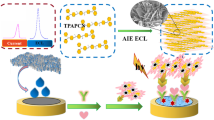Abstract
Mercury ions (Hg2+) mediating in situ heterojunction formation strategy based on spatially separated dual working areas was developed to achieve sensitive detection of human immunoglobulin G. To be specific, the complex of antibody, the silicon dioxide, and thymine-rich hairpin DNA were immobilized onto the antigen and antibody-modified electrodes, forming a special sandwich type where T-Hg2+-T structure could accommodate Hg2+. The zinc ions from zinc sulfide (ZnS) photoelectric materials were captured by Hg2+ to convert ZnS to zinc sulfide-mercuric sulfide nanocomposite. Such ion exchange approach with spatially separated working electrodes endowed the sensing platform with lower background interference and high selectivity, which also avoided damage of illumination on biomolecules. In addition, by regulating the ion recognition probe, the protocol could be extended to numerous other fields like clinical diagnosis, environmental monitoring, and public safety.
Graphical abstract







Similar content being viewed by others

References
Dong Y, Cao J, Wang B, Ma S, Liu Y (2017) Exciton−plasmon interactions between CdS@g-C3N4 heterojunction and Au@Ag nanoparticles coupled with DNAase-triggered signal amplification: toward highly sensitive photoelectrochemical bioanalysis of microRNA. ACS Sustainable Chem Eng 5:10840–10848. https://doi.org/10.1021/acssuschemeng.7b02774
Hu Y, Huang Y, Wang Z, Wang Y, Ye X, Wong W, Li C, Sun D (2018) Gold/WS2 nanocomposites fabricated by in-situ ultrasonication and assembling for photoelectrochemical immunosensing of carcinoembryonic antigen. Microchim Acta 185:570. https://doi.org/10.1007/s00604-018-3100-3
Wang R, Chen S, Ng YH, Gao Q, Yang S, Zhang S, Peng F, Fang Y, Zhang S (2019) ZnO/CdS/PbS nanotube arrays with multi-heterojunctions for efficient visible-light-driven photoelectrochemical hydrogen evolution. Chem Eng J 362:658–666. https://doi.org/10.1016/j.cej.2019.01.073
Yu L, Wen Y, Zhang X, Li N, Luo H (2020) Signal-off photoelectrochemical determination of miRNA-21 using aptamer-modified In2O3@Cu2MoS4 nanocomposite. Microchim Acta 187:561. https://doi.org/10.1007/s00604-020-04540-z
Liu Y, Zeng H, Chai Y, Yuan R, Liu H (2019) Ti3C2/BiVO4 schottky junction as a signal indicator for ultrasensitive photoelectrochemical detection of VEGF165. Chem Commun 55:13729–13732. https://doi.org/10.1039/C9CC07108C
Liu R, Wang Y, Wong W, Li H, Li C (2020) Photoelectrochemical immunoassay platform based on MoS2 nanosheets integrated with gold nanostars for neuron-specific enolase assay. Microchim Acta 187:480. https://doi.org/10.1007/s00604-020-04411-7
Qin C, Bai X, Zhang Y, Gao K (2018) Photoelectrochemical CdSe/TiO2 nanotube array microsensor for high-resolution in-situ detection of dopamine. Microchim Acta 185:278. https://doi.org/10.1007/s00604-018-2788-4
Qileng A, Yang S, Wei J, Lu N, Lei H, Liu Y, Liu W (2018) Construction of CdS/Ag2S-based broad-spectrum photoelectrochemical immunosensor for simultaneous assessment of ochratoxins by multivariable linear regression. Sens Actuators B Chem 267:216–223. https://doi.org/10.1016/j.snb.2018.04.026
Saikia D, Dutta P, Sarma NS, Adhikary NC (2016) CdTe/ZnS core/shell quantum dot-based ultrasensitive PET sensor for selective detection of Hg (II) in aqueous media. Sens Actuators B Chem 230:149–156. https://doi.org/10.1016/j.snb.2016.02.035
Lin Y, Zhou Q, Tang D, Niessner R, Yang H, Knopp D (2016) Silver nanolabels-assisted ion-exchange reaction with CdTe quantum dots mediated exciton trapping for signal-on photoelectrochemical immunoassay of mycotoxins. Anal Chem 88:7858–7866. https://doi.org/10.1021/acs.analchem.6b02124
Zhao Y, Tan L, Gao X, Jie G, Huang T (2018) Silver nanoclusters-assisted ion-exchange reaction with CdTe quantum dots for photoelectrochemical detection of adenosine by target-triggering multiple-cycle amplification strategy. Biosens Bioelectron 110:239–245. https://doi.org/10.1016/j.bios.2018.03.069
Qu Z, Yan L, Li L, Xu J, Liu M, Li Z, Yan N (2014) Ultraeffective ZnS nanocrystals sorbent for mercury(II) removal based on size-dependent cation exchange. ACS Appl Mater Interfaces 6:18026–18032. https://doi.org/10.1021/am504896w
Xu H, Huang D, Wu Y, Di J (2016) Photoelectrochemical determination of Cu2+ ions based on assembly of Au/ZnS nanoparticles. Sens Actuators B Chem 235:432–438. https://doi.org/10.1016/j.snb.2016.05.077
Pala IR, Brock SL (2012) ZnS nanoparticle gels for remediation of Pb2+ and Hg2+ polluted water. ACS Appl Mater Interfaces 4:2160–2167. https://doi.org/10.1021/am3001538
Zhang L, Li P, Feng L, Chen X, Jiang J, Zhang S, Zhang C, Zhang A, Chen G, Wang H (2020) Synergetic Ag2S and ZnS quantum dots as the sensitizer and recognition probe: a visible light-driven photoelectrochemical sensor for the “signal-on” analysis of mercury (II). J Hazard Mater 387:121715. https://doi.org/10.1016/j.jhazmat.2019.121715
Vilian ATE, Shahzad A, Chung J, Choe SR, Kim W, Huh YS, Yu T, Han Y (2017) Square voltammetric sensing of mercury at very low working potential by using oligomer-functionalized Ag@Au core-shell nanoparticles. Microchim Acta 184:3547–3556
Zhang L, Dong S (2006) Electrogenerated chemiluminescence sensors using Ru(bpy)32+ doped in silica nanoparticles. Anal Chem 78:5119–5123. https://doi.org/10.1021/ac060451n
Wang P, Sun G, Ge L, Ge S, Song X, Yan M, Yu J (2013) Paper-based photoelectrochemical immunosensing based on CdS QD sensitized multidimensional porous ZnO spheres promoted by carbon nanotubes. Chem Commun 49:10400–10402. https://doi.org/10.1039/C3CC45856C
Wang Y, Zhang L, Cui k, Ge S, Zhao P, Yu J, (2019) Paper-supported self-powered system based on a glucose/O2 biofuel cell for visual microRNA-21 sensing. ACS Appl Mater Interfaces 11:5114–5122. https://doi.org/10.1021/acsami.8b20034
Zhang Y, Xu J, Zhou S, Zhu L, Lv X, Zhang J, Zhang L, Zhu P, Yu J (2020) DNAzyme-triggered visual and ratiometric electrochemiluminescence dual-Rreadout assay for Pb(II) based on an assembled paper device. Anal Chem 92:3874–3881. https://doi.org/10.1021/acs.analchem.9b05343
Tang R, Zhou S, Yuan Z, Yin L (2017) Metal-organic framework derived Co3O4/TiO2/Si heterostructured nanorod array photoanodes for efficient photoelectrochemical water oxidation. Adv Funct Mater 27:1–12. https://doi.org/10.1002/adfm.201701102
Dloczik L, Könenkamp R (2003) Nanostructure transfer in semiconductors by ion exchange. Nano Lett 3:651–6533. https://doi.org/10.1021/nl0340879
Funding
The work was financially supported by the National Natural Science Foundation of China (21874055), the Taishan Scholars Program, the Project of “20 items of University” of Jinan (2018GXRC001), and Case-by-Case Project for Top Outstanding Talents of Jinan and the Excellent Youth Innovation Team in Universities of Shandong (2019KJC016).
Author information
Authors and Affiliations
Corresponding authors
Ethics declarations
Conflict of interest
The authors declare no competing interests.
Additional information
Publisher's note
Springer Nature remains neutral with regard to jurisdictional claims in published maps and institutional affiliations.
Supplementary Information
Below is the link to the electronic supplementary material.
Rights and permissions
About this article
Cite this article
Shi, H., Li, L., Zhang, L. et al. In situ controllable heterojunction conversion strategy driven by oriented paper-based fluid transfer for human immunoglobulin G detection. Microchim Acta 188, 373 (2021). https://doi.org/10.1007/s00604-021-05017-3
Received:
Accepted:
Published:
DOI: https://doi.org/10.1007/s00604-021-05017-3



